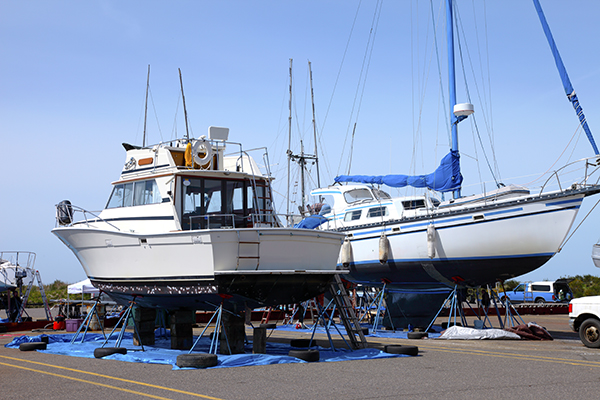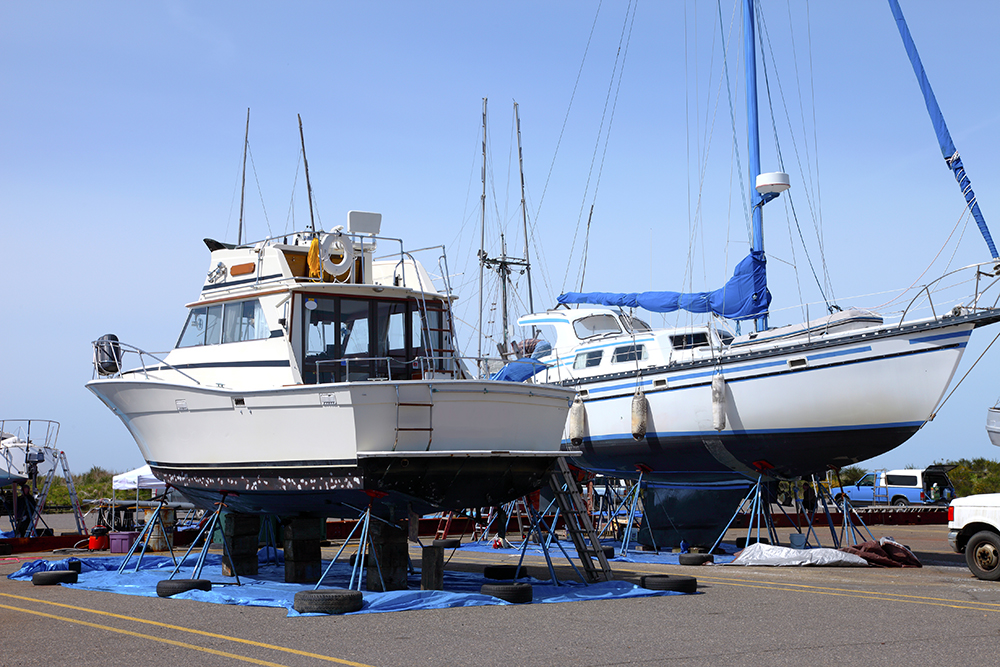

It’s been a great summer of boating and now it is time to begin preparing your boat for winter. If your boat is hauled out for winter storage, here are 5 ways to prepare your boat for winter storage from one of our insurance carriers that will help you ensure that your vessel will be ready for safe and reliable cruising again next year.
We will present this information in 5 parts, today’s post will focus on tasks before the haulout, outside the boat. When the boat is afloat and tied to the dock, it’s easier to get on and off than it will be when she’s hauled out, so now is the time to do as much of the heavy lifting as possible.
1. Clean Anchors and Remove Canvas
Remove canvas covers, deck and cockpit cushions, extra mooring lines, fenders and anything else on deck that should go ashore for winter storage. If it’s possible, tie the boat with her bow over a dock or walkway, drop the anchor on the dock and pull out all the anchor rode so you can rinse the chain and rope with fresh water. If you plan to leave the rode in the anchor locker for the winter, be sure to let everything dry thoroughly, and be sure the locker is clean and dry before re-stowing it.
2. Inspect Sails and Rigging
If you have a sailboat, now is the time to remove the sails, flake them neatly on the dock and put them in their sailbags. It’s a good time to give the sails a careful inspection to identify any repairs or cleaning that may need to be done by your sailmaker during the winter. Tie messenger lines to your halyards and remove them so they won’t be damaged by winter weather. Even if the mast will be removed for the winter, it’s easier to pull the halyards out when the mast is vertical.
It’s a good idea to take all your running rigging off the boat (don’t forget to reeve messenger lines) so you can inspect it all, repair any frayed ends or replace any chafed lines that you didn’t repair during the season. Dacron running rigging can be cleaned by soaking in a mild detergent solution, then soaking in fresh rinse water, and drying before stowing. Nylon mooring lines can be cleaned the same way, which will rid them of abrasive salt residue and extend their service life. Check with the manufacturer before cleaning high-tech cordage like Spectra, etc.
3. Unstep the Mast
Even if you don’t normally unstep the mast for winter storage, it’s a good idea to do it every few years so you or your rigger can inspect all the rigging and fittings, especially the ones at the masthead. If the mast will be removed this year, straighten the cotter pins in the turnbuckles so that they can be quickly removed when the yard sets up the crane to lift the mast. Remove the mainsheet, and then remove the boom and lay it on the coachroof or side deck. Use lifejackets or cushions to pad the boom so it won’t scratch the boat. Keep track of any shims that come out of the gooseneck, so that you can replace them in the spring.
Before you loosen any turnbuckles, measure the distances between the upper and lower halves of the turnbuckle bodies and write them all down. That way, you’ll be able to set all the stays and shrouds at the same tension next spring, which could save a lot of time tuning the rig. Disconnect and tag the mast wiring, and remember to protect the connectors from the weather if they’re on deck.
4. Check Your Shore Power for Hazards
If your boat is equipped with AC shore power, turn off the circuit breaker on the dock first, and then disconnect the cord from the boat. Take a close look at the boat’s shore power receptacle. If you see any sign of darkening of the plastic around one of the prongs, replace the connector. You don’t need to buy a whole new receptacle fitting; just replace the internal parts. If one of the prongs in the connector in the boat’s receptacle is damaged, it’s possible that the corresponding clip in the end of the cord is damaged too, and it may be time for a new shore power
cord as well. That receptacle, where the cord plugs into the boat, is a very common source of fire on boats. Be sure your shore power connection is in like-new condition!
5. Check the Gas System and Give the Boat a Good Cleaning
If your boat is equipped with a propane (LPG) or compressed natural gas (CNG) system, be sure the valves are turned off at the tanks. Take a close look at everything in the tank locker (tanks, regulator, pressure gauge, solenoid valve, wiring, etc.) to be sure all is properly secured and in good repair. Be sure the vapor drain at the bottom of the locker is clear, and that every wire and hose that passes into the locker is properly sealed so any leaking gas can’t get inside the boat. Finally, since running water isn’t always available in storage yards, give the boat a thorough washing before she’s hauled out.
Our Marine Team knows boat insurance inside and out. You’ve put a lot of time, money and effort into your vessel, now let Wells Marine Insurance carefully protect your boat from perils. Visit us at wellsmarineins.com or stop by our Wrightsville Beach office.



Very good advice, this time of the year can be very harsh on the boat if one is not careful therefore, it is imperative to take steps to keep it safe in order to ensure that there are no costly repairs needed.